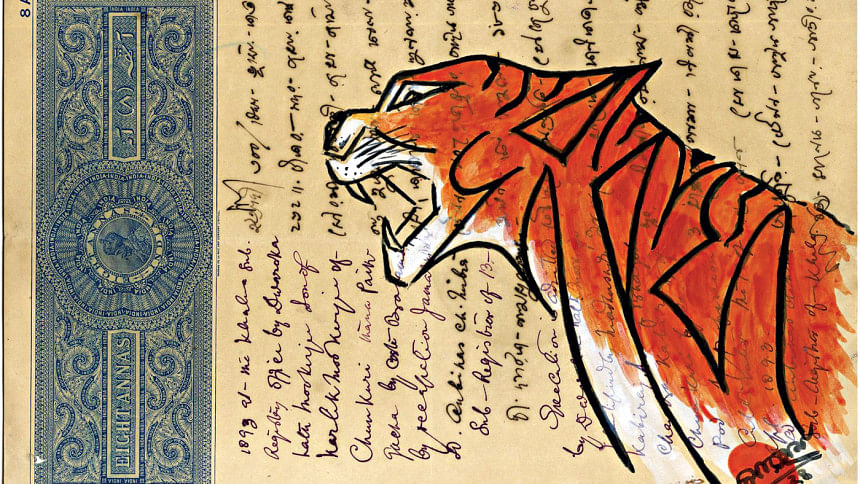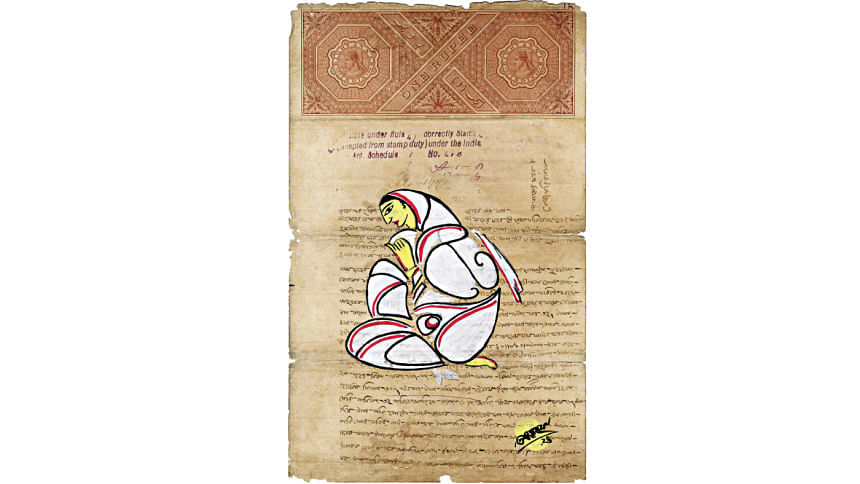Dolile drishyapot: A celebration of Bangla calligraphy

Imagine entering a gallery filled with canvases, where sepia-toned papers with brittle edges and faded ink burst into life with vibrant colours and witty catchphrases from ancient Bengal. On his 20th solo exhibition — the versatile artist Arham-ul-Huq Chowdhury presents one such immersive show titled "Decorated Deeds: Bangla Calligraphy on Antique Documents" (Dolile Drishyapot).
The ongoing exhibition is being hosted at La Galerie of Alliance Française de Dhaka in the capital's Dhanmondi. The event was inaugurated on 14 April to welcome the Bangla New Year. It features 31 artworks as Chowdhury breathes new life into worn-out administrative paperwork with a unique blend of our linguistic heritage, refreshing colours, and old-school aesthetics.
"Some of the papers are over 150 years old," commented Chowdhury, the calligraphy artist, sculptor, landscape and interior designer who also works with heritage and environmental issues. "Many of them date back to the East India Company era (early to mid-1800s), the British colonial period, and the Pakistan era."
According to the freelance researcher, even though the original purpose of these papers has long been served, they still have lots to say. "Every piece is a conversation between the past and the present, telling stories that might otherwise fade."
One of the fascinating aspects of this show is the revival of Bengali proverbs.

We all grew up hearing sayings like: "Lekhapora kore je gaari-ghora chore shey" (He who studies rides cars and horses), "Bel pakle kaaker ki" (What matters to the crow if the wood apple is ripe), "Dhar kore haati kena" (Buying elephant with borrowed money), etc. For this show, Chowdhury drew inspiration from these sayings and attempted to render the essence of the phrases with acrylic on paper.
Artistic portrayals of gods and goddesses, sacred trees, and boats, fierce Bengal Tigers, royal horses, and majestic elephants — vivid storytelling is at the core of Decorated Deeds. Visitors were spotted interpreting the meaning of the idioms while wondering which era the old documents belonged to!
"One of my favourite pieces is 'Paaperdhon shape khay' (Evil earning is eaten by snakes)," remarked Ajanta, a visitor at the gallery. "I think the lesson here is timeless," she added with a smile.
Common expressions we use in our day-to-day lives, such as "Laat Shaheb," "Bheja Biral," or "Koler Putul," came alive with Chowdhury's skilled brushstrokes. Reflecting on his inspiration behind bringing back these sayings, the artist stressed that these phrases and idioms speak to the core of human nature.

"Bengali language is rich with philosophy, metaphor, and lived experience. Often wrapped in humour, satire, or poetic imagery, their truths remain startlingly suitable in today's fast-paced, digital world," he observed.
Prapti, another visitor, admired the creative resurrection of the century-old bureaucratic papers as one-of-a-kind canvases. "The stylish calligraphy and playful messages make this show stand out," she mentioned.
After almost three decades of practising as a calligraphy artist, Arham-ul-Huq-Chowdhury's approach in Bangla calligraphy is a blend of classical form and experimental design, taking a cue from the Persian Islamic "tughra."
This exhibition is, in his words — a tribute to our collective memory and a reminder to value what we inherit. So, if you are in the mood for retro vibes and colourful wordplay, drop in anytime from 3:00pm to 9:00pm. The exhibition concludes on April 26.

 For all latest news, follow The Daily Star's Google News channel.
For all latest news, follow The Daily Star's Google News channel. 



Comments